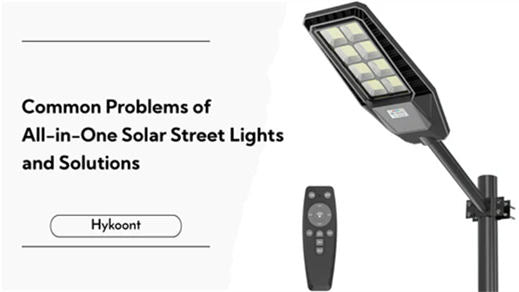89All-in-one solar street lights are becoming increasingly popular due to their energy efficiency and environmental friendliness. However, like any technology, they are prone to encountering certain issues during operation. In this blog post, we will discuss some of the common problems associated with all-in-one solar street lights, including issues with the solar panel, LED chips, and more. Additionally, we will provide detailed solutions to address these challenges effectively.
Reduced Efficiency of Solar Panel
Over time, the solar panel's efficiency may decrease due to various factors such as dust accumulation, shading, or improper positioning. Reduced efficiency can lead to inadequate charging of the battery and decreased overall performance of the solar street light system.
Solution:
- Ensure Proper Positioning: The solar panel should be positioned to receive maximum sunlight exposure throughout the day. Proper orientation ensures optimal energy absorption and charging efficiency.
- Clean the Panel Regularly: Dust, dirt, and debris can accumulate on the surface of the solar panel, obstructing sunlight and reducing efficiency. Regularly clean the panel with a soft cloth and mild detergent to maintain optimal performance.
- Check for Shading: Nearby trees, buildings, or other obstructions may cast shadows on the solar panel, reducing its ability to generate electricity. Identify and remove any objects that cause shading to maximize sunlight exposure.

Dim or Flickering LED Lights
Dim or flickering LED lights are indicators of potential issues within the solar street light system, such as low battery voltage or faulty connections. Diminished illumination can compromise safety and visibility in outdoor environments.
Solution:
- Check Battery Health: Dim or flickering LED lights may signal a low battery voltage. Verify that the battery is adequately charged and functioning properly to ensure consistent illumination throughout the night.
- Inspect LED Connections: Examine the connections between the LED chips and the circuit board for any loose, corroded, or damaged wiring. Secure or replace any faulty connections to restore optimal performance.
- Upgrade LED Driver: Outdated or incompatible LED drivers can cause irregularities in LED performance. Consider upgrading to a more efficient and reliable LED driver to ensure stable and consistent illumination.

Corrosion or Damage to Components
Corrosion or physical damage to components such as metal fixtures, connections, or housing can compromise the structural integrity and functionality of the solar street light system, leading to premature failure or malfunction.
Solution:
- Regular Maintenance: Implement a routine maintenance schedule to inspect all components of the solar street light system for signs of corrosion, wear, or damage. Timely replacement of deteriorated parts prevents further deterioration and ensures reliable operation.
- Use High-Quality Materials: Opt for corrosion-resistant materials and components during installation or replacement to enhance the system's durability and longevity, particularly in harsh outdoor environments.
- Apply Protective Coatings: Coat vulnerable components such as metal fixtures and connections with protective coatings or sealants to provide an additional layer of defense against moisture, humidity, and environmental damage.
Inconsistent Performance in Extreme Weather Conditions
Extreme weather conditions, such as strong winds, heavy rainfall, or extreme temperatures, can adversely affect the performance and reliability of solar street lights, resulting in inconsistent operation or potential damage.
Solution:
- Select Appropriate Location: Choose installation sites for solar street lights that are sheltered from extreme weather conditions or located in areas less prone to environmental hazards. Strategic placement minimizes exposure to adverse weather elements and ensures consistent performance.
- Install Wind and Rain Shields: Install protective shields or covers around the solar panel, LED lights, and other sensitive components to shield them from direct exposure to harsh weather elements. Wind and rain shields enhance durability and protect against water ingress or physical damage.
- Optimize System Design: Collaborate with experienced professionals to design and customize the solar street light system according to the specific environmental challenges of the installation location. Tailored design solutions, such as reinforced structures or additional weatherproofing measures, optimize performance and resilience in extreme weather conditions.

LED Chip Problems:
LED chips are integral components of solar street lights, responsible for providing illumination. Premature failure of LED chips can result in reduced brightness or complete malfunction of the lighting system.
Solution:
- Optimal Drive Current: LED chips should be operated within their specified drive current range to prevent overheating and premature failure.
- Quality Assurance: Ensure the use of high-quality LED chips from reputable manufacturers with proven reliability and longevity.
- Proper Heat Dissipation: Implement efficient heat dissipation mechanisms to maintain optimal operating temperatures and prolong the lifespan of LED chips.

Inadequate Heat Dissipation Leading to LED Degradation:
Heat dissipation is crucial for LED chips to maintain their performance and longevity. Inadequate heat dissipation can accelerate LED degradation and shorten the lifespan of solar street lights.
Solution:
- Heat Sink Design: Incorporate robust heat sinks with sufficient surface area and thermal conductivity to effectively dissipate heat generated by the LED chips.
- Natural Convection: Position the solar street light in a location that allows for natural convection airflow around the heat sink to enhance heat dissipation.
- Thermal Management System: Install temperature sensors and intelligent thermal management systems to monitor and regulate the temperature of LED chips, ensuring optimal performance and longevity.
Damage to LED Chips and Electronic Components Due to Power Surges or Lightning Strikes
Power surges or lightning strikes can cause irreparable damage to LED chips and electronic components of solar street lights, leading to system failure.
Solution:
- Surge Protectors: Install surge protection devices such as transient voltage suppressors (TVS) or surge arresters to divert excess voltage away from the solar street light system during power surges or lightning strikes.
- Grounding System: Implement a robust grounding system to dissipate electrical surges safely into the ground, protecting sensitive electronic components from damage.
- Isolation Transformers: Use isolation transformers to isolate the solar street light system from the main power supply, providing an additional layer of protection against electrical disturbances and surges.
Conclusion:
While all-in-one solar street lights offer numerous advantages, they may encounter various challenges during operation. By addressing common problems such as reduced solar panel efficiency, dim or flickering LED lights, component corrosion, and inconsistent performance in extreme weather conditions with effective solutions, users can ensure the reliable and long-term functionality of their solar street light systems. Regular maintenance, proper installation, and the use of high-quality materials are key factors in maximizing the performance and durability of all-in-one solar street lights.


































Leave a comment
This site is protected by hCaptcha and the hCaptcha Privacy Policy and Terms of Service apply.